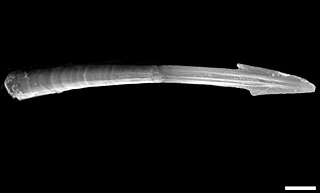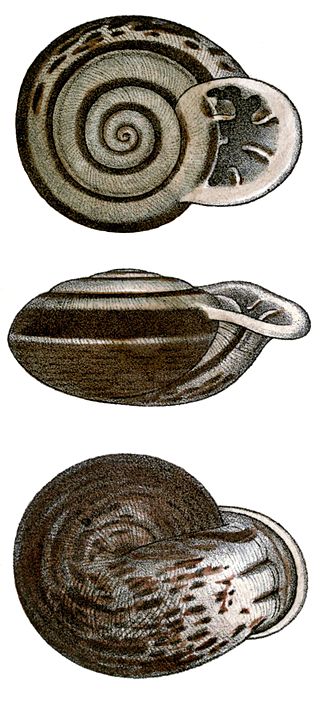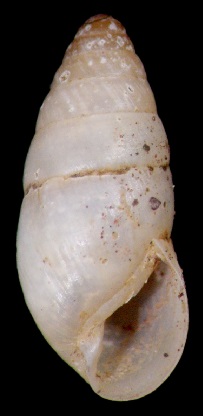
Ancylini is a tribe of small, freshwater, air-breathing limpets, aquatic pulmonate gastropod mollusks in the family Planorbidae, the ram's horn snails and their allies. This tribe used to be treated as a family; the current taxonomic placement within Planorbidae is according to the taxonomy of the Gastropoda.
Gundlachia is a genus of minute freshwater snails or limpets, aquatic pulmonate gastropod mollusks in the family Planorbidae, the ram's horn snails and their allies.
Digerus gibberulus is an extinct species of air-breathing land snail, a terrestrial pulmonate gastropod mollusk in the family Odontostomidae. cf.

A land snail is any of the numerous species of snail that live on land, as opposed to the sea snails and freshwater snails. Land snail is the common name for terrestrial gastropod mollusks that have shells. However, it is not always easy to say which species are terrestrial, because some are more or less amphibious between land and fresh water, and others are relatively amphibious between land and salt water.

A love dart is a sharp, calcareous or chitinous dart which some hermaphroditic land snails and slugs create. Love darts are both formed and stored internally in a dart sac. These darts are made in sexually mature animals only, and are used as part of the sequence of events during courtship, before actual mating takes place. Darts are quite large compared to the size of the animal: in the case of the semi-slug genus Parmarion, the length of a dart can be up to one fifth that of the semi-slug's foot.

Anostoma, common name the up-mouth snails, is a genus of tropical air-breathing land snails, terrestrial pulmonate gastropod mollusks in the family Odontostomidae. Snails in this genus are found in Brazil.
Anostoma baileyi is a species of air-breathing land snail, a terrestrial pulmonate gastropod mollusc in the family Odontostomidae.
The respiratory system of gastropods varies greatly in form. These variations were once used as a basis for dividing the group into subclasses. The majority of marine gastropods breathe through a single gill, supplied with oxygen by a current of water through the mantle cavity. This current is U-shaped, so that it also flushes waste products away from the anus, which is located above the animal's head, and would otherwise cause a problem with fouling.

Megalobulimus oblongus, also known as Strophocheilus oblongus, is a species of air-breathing land snail, a terrestrial pulmonate gastropod mollusk in the family Strophocheilidae.
Gundlachia radiata is a species of minute freshwater snail or limpet, an aquatic pulmonate gastropod mollusk or micromollusk in the family Planorbidae.

Vegrandinia is a genus of medium-sized air-breathing land snails, terrestrial pulmonate gastropods in the family Achatinidae. The genus name refers to its small size.
Uncancylus is a genus of small, freshwater, air-breathing limpets, aquatic pulmonate gastropod molluscs in the family Planorbidae, the ram's horn snails and their allies.
Uncancylus concentricus is a species of small, freshwater, air-breathing limpet, an aquatic pulmonate gastropod mollusc in the family Planorbidae, the ram's horn snails and their allies.
Anisancylus dutrae is a species of small, freshwater, air-breathing limpet, an aquatic pulmonate gastropod mollusc in the family Planorbidae, the ram's horn snails and their allies.
Anisancylus obliquus is a species of small, freshwater, air-breathing limpet, an aquatic pulmonate gastropod mollusc in the family Planorbidae, the ram's horn snails and their allies.
Uncancylus foncki is a species of small, freshwater, air-breathing limpet, an aquatic pulmonate gastropod mollusc in the family Planorbidae, the ram's horn snails and their allies.
Hebetancylus is a genus of small, freshwater, air-breathing limpets, aquatic pulmonate gastropod molluscs in the family Planorbidae, the ram's horn snails and their allies.
Hebetancylus moricandi is a species of small, freshwater, air-breathing limpet, an aquatic pulmonate gastropod mollusc in the family Planorbidae, the ram's horn snails and their allies.
Laevapex is a genus of small, freshwater, air-breathing limpets, aquatic pulmonate gastropod molluscs in the family Planorbidae, the ram's horn snails and their allies.
Laevapex vazi is a species of small, freshwater, air-breathing limpet, an aquatic pulmonate gastropod mollusc or micromollusc in the family Planorbidae, the ram's horn snails and their allies.





